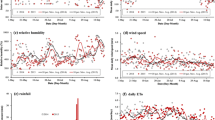Abstract
Irrigation frequency is one of the most important factors in drip irrigation scheduling, and a proper irrigation frequency can establish moderate moist and oxygen conditions in the root zone throughout the crop period. Field experiments on the effects of irrigation frequency on radish growth and water use were carried out in 2001 and 2002. The experiment included six irrigation frequencies: once every day, once every 2 days, once every 3 days, once every 4 days, once every 6 days and once every 8 days. There was no significant difference among the six treatments on radish development and yield, but significant differences in radish roots distribution and market quality were found. Radishes irrigated once every 3 days had well-developed roots throughout the crop period, the lowest cracking rate and the least number of radishes of Grade 3. The observation results of lysimeter in 2002 showed that radish evapotranspiration decreased as irrigation frequency decreased, and the general changing tendency of 2-day ET of high irrigation frequency was related to that of 2-day evaporation. It is recommended that radish irrigation frequency should be once every 3 days and the irrigation amount should be estimated according to the evaporation of 20 cm diameter pan in the North China Plain.















Similar content being viewed by others
References
Barker AV, Laplante JF, Daman RA (1983) Growth and composition of radish under various regimes of nitrogen nutrition. J Am Soc Hortic Sci 108:1035
Beese F, Horton R, Wierenga PJ (1982) Physiological response of chile pepper to trickle irrigation. Agron J 74:551–555
Bucks DA, Erie LJ, French OF (1974) Quantity and frequency of trickle and furrow irrigation for efficient cabbage production. Agron J 66:53–57
Goldberg SD, Shmueli M (1970) Drip irrigation—a method used under arid and desert conditions of high water and soil salinity. Trans ASAE 13:38–41
Goldberg SD, Rinot M, Karu N (1971) Effect of trickle irrigation intervals on distribution and utilization of soil moisture in a vineyard. Soil Sci Soc Am Proc 35:127–130
Huang B, Johnson JW, NeSmith S, Bridge DC (1994) Growth, physiological and anatomical responses of two wheat genotypes to waterlogging and nutrient supply. J Exp Bot 45:193–202
Kang Y, Wang FX, Liu HJ, Yuan BZ (2004) Potato evapotranspiration and yield under different drip irrigation regimes. Irrig Sci 23:133–143
Levin I, Assaf R, Bravdo BA (1979a) Soil moisture and root distribution in an apple orchard irrigated by trickles. Plant Soil 52:31–40
Levin I, Van Pooyen P, Van Rooyen F (1979b) The effect of discharge rate and intermittent water application by point source irrigation on the soil moisture distribution pattern. Soil Sci Soc Am J 43:8–16
Liao CT, Lin CH (1994) Effect of flooding stress on photosynthetic activities of Momordica charantia. Plant Physiol Biochem 32:1–5
Meshkat M, Warner RC, Workman SR (2000) Evaporation reduction potential in an undisturbed soil irrigated with surface drip and sand tube irrigation. Trans ASAE 43(1):79–86
Oktem A, Simsek M, Oktem AG (2003) Deficit irrigation effects on sweet corn (Zea mays saccharata Sturt) with drip irrigation system in a semi-arid region I. Water-yield relationship. Agric Water Manage 61:63–74
Park KW, Fritz D (1982) Study on radish quality (Raphanus sativus L. var. niger (Mill) S. Kerner). Part I. Effect of soil moisture, seasons, harvesting period and fertilization on texture of radish. J Korea Soc Hortic Sci 23:188–192
Pezeshki SR (1994) Plant responses to flooding. In: Wilkinson RE (ed) Plant environment interactions. Marcel Dekker Inc, New York, pp 289–312
Radin JW, Mauney JR, Kerridge PC (1989) Water uptake by cotton roots during fruit filling in relation to irrigation frequency. Crop Sci 29(4):1000–1005
Singh K, Cheema GS (1972) Effect of nitrogen, sulphur and potash fertilizers on the mineral composition and metabolites of radish (Raphanus sativus L.). Haryana J Hortic Sci 14:71–75
Smasjtrla AG, Harrison DS, Clark GA (1985) Trickle irrigation scheduling I. Duration of water application. IFAS Bulletin 204, University of Florida, Gainesville
Yuan BZ, Kang Y, Nishiyama S (2001) Drip irrigation scheduling for tomatoes in unheated greenhouses. Irrig Sci 20:149–154
Acknowledgements
This study is the part works of the Project 40125002 supported by National Science Fund for Distinguished Young Scholars and the Project 2002AA2Z4061 supported by National High Technology Research and Development Program
Author information
Authors and Affiliations
Corresponding author
Additional information
Communicated by J. Ayars
Rights and permissions
About this article
Cite this article
Wan, S., Kang, Y. Effect of drip irrigation frequency on radish (Raphanus sativus L.) growth and water use. Irrig Sci 24, 161–174 (2006). https://doi.org/10.1007/s00271-005-0005-9
Received:
Accepted:
Published:
Issue Date:
DOI: https://doi.org/10.1007/s00271-005-0005-9




